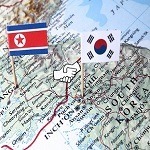Recently, North Korean leader Kim Jong-un said he wanted “to vigorously advance” inter- Korean links and his goal is reunification.1)North Korea ‘seeks closer South Korea ties, reunification’, Aljazeera 2018-03-06.On 27th April he met Mun Dze In, leader of South Korea.
Strategists, politicians and economists are ignoring the depopulation that is taking place, the single most crucial issue that will make or break the nation, shape the global economy and geopolitical order. The South Korean overall population has just started to shrink whith its working age population is in a free fall. In 30 years it will have decreased by 10 to 20%!
South Korea suffers a labour shortage. Ten percent of the positions in the electronic industry remain vacant, and the worse is still ahead. At the end of last year the South Korean government said that in the following year it would accept 56,000 foreign workers on the low-skilled work scheme, the same number as in the current year, as part of its efforts to tackle the labour shortage. A shrinking population brings about replacement migration, and it will destroy the national culture and society as it is happening in Western Europe and the United States.
East Asian labour shortage (Korea, Taiwan, Japan) will also affect the US consumer-based economy because these Asian countries provide the US with high tech goods in return for paper promises. The South Koreans have to expand their workforce, and North Korea can solve that problem. North Korea is developing at a slower pace than South Korea due to its ineffective socialist economic model. Kaesong Industrial Region is located on both sides of the border between North and South Korea. There North Koreans are allowed to work in South Korean factories. Many manufacturing plants are in North Korea by the Chinese because the country has an educated population (which is why it has been capable of building rockets, submarines and nuclear facilities).

South Korea has one of the world’s lowest fertility rates.2)The collapse of the South Korean community: the countdown has begun, Gefira 2018-01-18.According to the World Bank, the demographic situation in North Korea seems to look better. Since 1995 the fertility rate has been below replacement (2,1); still, is about 2 and is decreasing at a slow pace. In South Korea the fertility rate is shrinking because of women participation in labour, whereas in the north it is caused by the famine of 1994-1998 and insufficient health care.3)Demographics of North Korea, Wikipedia 2017-08-13.The merge of Koreas would not help South Korea out of the demographic decline for a long time.

In the Democratic People’s Republic of Korea the birth rate (0,5%) is almost twice bigger, so is the death rate. The mortality rate among infants is about five times bigger (15,1 deaths per 1000 live births); this last problem could be tackled with the help of the South. In South Korea, the life expectancy is about ten years longer (82,024). Now Korea (as a whole) has over 77 mln people, by about 2030 it will reach 79 mln and by about 2065 it will fall to 66 mln.

The two Koreas are different countries and societies. South Koreans would see the north part as a problem where they would have to invest a lot of money. North Korea is the most isolated country in the world, while South Korea is one of the most open, free and technologically advanced societies. North Koreans would need extra training and education to be able to work in the south.
It will not be easy to merge North with South Korea, but at least both communities share the same culture and ethnicity. The two neighbouring states need each other: South Korea might help develop technology in return for labour consumer market from North Korea. There is little doubt the countries will merge in the nearest future.
References
| 1. | ↑ | North Korea ‘seeks closer South Korea ties, reunification’, Aljazeera 2018-03-06. |
| 2. | ↑ | The collapse of the South Korean community: the countdown has begun, Gefira 2018-01-18. |
| 3. | ↑ | Demographics of North Korea, Wikipedia 2017-08-13. |




